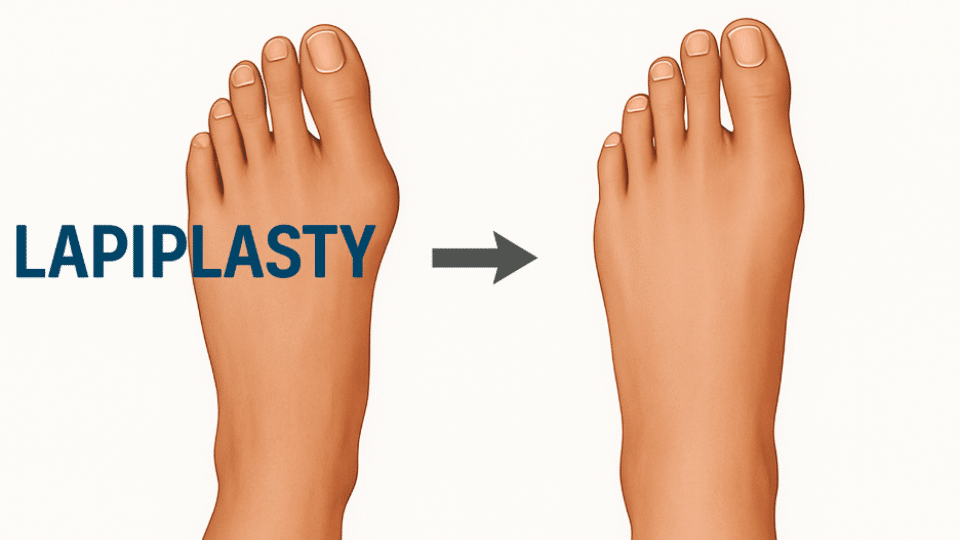Are you tired of the pain and discomfort from bunions? Millions worldwide suffer from this common foot issue. But, what if a more effective, innovative solution existed?
Lapiplasty is a groundbreaking bunion surgery. It offers faster recovery and long-term results. Unlike traditional methods, this advanced procedure corrects the deformity in three dimensions. This provides a more stable and lasting correction.
Lapiplasty is changing the game in bunion correction by tackling the deformity’s root cause. Unlike traditional surgeries, which mainly aim to alleviate symptoms, Lapiplasty corrects the underlying bone structure. This provides a more stable and enduring solution.
The Root Cause of Bunions and Why Lapiplasty Addresses It
Bunions are often caused by genetic predisposition, poorly fitting shoes, and abnormal foot mechanics. Lapiplasty addresses the root cause by correcting the misaligned bone and restoring the foot’s natural anatomy. This not only relieves bunion pain but also enhances the foot’s function and appearance.
Understanding how Lapiplasty works and its differences from traditional bunion surgeries helps you make an informed choice. To determine if Lapiplasty is the right option for you, a detailed consultation with a foot and ankle specialist is necessary. This thorough assessment ensures that Lapiplasty is tailored to your specific needs and that you’re fully informed about the procedure’s benefits and recovery process.
What Sets Lapiplasty Apart from Traditional Bunion Surgery
One of the standout features of Lapiplasty is its ability to perform a 3D correction of the bunion deformity. Traditional bunion surgeries generally focus on realigning the bone in two dimensions, shifting the bunion sideways and sometimes rotating the big toe. While this can provide some relief, it often doesn’t address the underlying cause of the deformity, which lies in the complex three-dimensional structure of the foot.
What Does 3D Correction Mean?
The 3D correction approach used in Lapiplasty goes beyond just moving the big toe into alignment. Instead, it corrects the misalignment in all three planes:
- Medial (side-to-side): Lapiplasty shifts the big toe in the horizontal direction, addressing the sideways angling of the bone.
- Rotational (twist): It realigns the toe’s angle and rotation, which often occurs when the big toe twists inward due to the bunion.
- Vertical (up-and-down): The third dimension involves repositioning the bone vertically, correcting any elevation changes at the joint that may contribute to misalignment and instability.
By correcting the bunion deformity in three dimensions, Lapiplasty effectively addresses the root cause of the condition. This comprehensive approach ensures a more stable and lasting correction compared to traditional methods, which only treat the bunion in two dimensions. For additional insights into bunion treatments and how Lapiplasty compares to other options, check out our Bunion Treatment Blog.
The Benefits of Choosing Lapiplasty Bunion Surgery
- Longer-Lasting Results: Traditional bunion surgeries may lead to the bunion reoccurring over time because they don’t correct the deformity in all three planes. By realigning the bone in 3D, Lapiplasty provides a more stable, durable fix that reduces the likelihood of recurrence.
- Restores Natural Foot Anatomy: 3D correction helps restore the natural anatomy of the foot, improving foot mechanics and function. This can relieve pain, improve balance, and enhance overall mobility.
- Faster Recovery: Because the 3D correction directly addresses the misalignment of the bones, it provides a more stable foundation for the foot, leading to a quicker recovery and less strain on surrounding tissues.
By choosing Lapiplasty bunion surgery, you’re not only addressing the current bunion issue but also investing in the long-term health and appearance of your foot. With its combination of faster recovery, lower recurrence rates, and improved foot function and aesthetics, it stands out as a superior choice for bunion correction.

Before Your Procedure: Consultation and Preparation
Before the Lapiplasty procedure, a detailed consultation with a specialist at Fall Creek Foot & Ankle is required. Your doctor will evaluate the severity of your bunion, discuss your symptoms, and outline a treatment plan suited to your needs. The preparation for surgery may include:
- Pre-operative exams to ensure you’re healthy enough for surgery.
- Discussion of any medications you’re currently taking.
- Instructions on how to prepare for the day of the surgery.
Assessing if you’re a suitable candidate for the Lapiplasty procedure requires a comprehensive evaluation by a specialist. Factors such as the severity of your bunion, overall health, and previous treatments are considered. If you’re dealing with bunions and seeking a reliable, long-term solution, Lapiplasty bunion surgery could be the ideal option for you.
The Lapiplasty Procedure at Fall Creek Foot & Ankle
At Fall Creek Foot & Ankle, the Lapiplasty procedure represents a groundbreaking method for bunion correction. This advanced surgical technique aims to tackle the underlying causes of bunions. It offers a more stable and enduring solution compared to traditional bunion surgery approaches.
Take the next step toward achieving the comfort and confidence you deserve. Schedule a consultation today to learn more about Lapiplasty.
